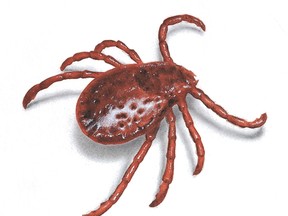Public health shows how to avoid Lyme disease caused by blacklegged ticks

Article content
Ticks are rare in Oxford but they do find their way here and with them the potential for Lyme disease.
“Typically in any given year we have 30 to 40 ticks submitted for identification,” explained Peter Heywood, manager of health protection at Oxford County public health.
The ticks are submitted to first determine whether it is a black-legged tick, the type of tick that can cause Lyme disease.
If the tick is black-legged variety, then it is submitted to a second lab to determine if it carried Lyme disease.
At that time public health advises the person who submitted the tick to watch for and be aware of the signs and symptoms of ticks.
Last year, Heywood said public health investigated two cases of Lyme disease in Oxford County.
Early symptoms include a circular rash — known as bull’s-eye rash — as well as fever, chills and extreme fatigue.
“It’s important people seek medical attention right away and tell their doctor where they have been,” Heywood said. “Lyme disease can be quite serious if left untreated.”
While Oxford County is not considered a risk area for ticks, many people from the county visit risky areas such as Turkey Point, Point Pelee and Long Point provincial parks.
But there are other ways local residents can be exposed to ticks.
“Black-legged ticks can attach themselves to birds that fly into Oxford County,” Heywood explained.
Lyme disease is the most common vector borne disease, or infection transmitted by the bite of infected arthropod species.
“In the United States there are 300,000 cases a year,” Heywood said. “It’s very common.”
Ticks, he said, are slowly pushing themselves northward due to increasing temperatures caused by climate change.
Tips to avoid ticks include applying insect repellent with DEET, staying out of overgrown bushes and vegetation, and carefully checking clothing and your body for ticks.
If you find a tick on your body its important to remove it using tweezers where you grab it by head and mouth, and pull it straight out as close to your body as possible.
Ticks should be removed within 24 hours of the bite and be submitted to public health for identification.